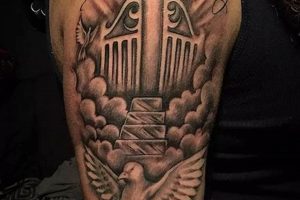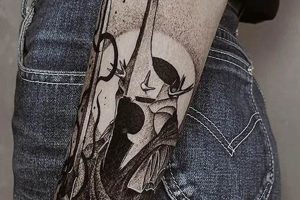Arboreal body art encompasses a wide range of symbolic imagery, from sprawling oak and willow designs to delicate cherry blossom branches and minimalist evergreen silhouettes. These designs can be rendered in various styles, including realistic, watercolor, tribal, geometric, and silhouette, often incorporating elements like roots, leaves, flowers, or birds.
Representations of trees in body art have deep cultural and personal significance. They can symbolize strength, resilience, growth, connection to nature, family heritage, or the cycle of life. The specific type of tree chosen often carries its own unique meaning, adding a layer of personal storytelling to the design. This rich symbolism, combined with the artistic potential of diverse tree forms, makes such artwork a popular choice.
Exploration of specific tree types and their symbolism, stylistic choices, placement considerations, and the artistic process involved in designing and executing these tattoos will provide a comprehensive understanding of this enduring form of personal expression.
1. Tree Species Symbolism
The selection of a specific tree species for a tattoo significantly impacts the overall meaning conveyed. Different trees hold distinct cultural and symbolic weight, allowing for personalized expressions of connection, resilience, growth, and heritage. Understanding these symbolic associations is crucial for creating a meaningful and resonant design.
- The Oak: Strength and Wisdom
Oaks, often revered for their size and longevity, represent strength, wisdom, and endurance. A sprawling oak tattoo can symbolize a deep connection to these qualities, reflecting inner resilience and a grounded nature. Examples include depictions of a sturdy oak with deep roots, signifying stability and connection to heritage.
- The Willow: Adaptability and Healing
Willows, known for their flexibility and proximity to water, embody adaptability, healing, and emotional depth. A willow tattoo can signify an ability to navigate life’s challenges with grace and embrace emotional growth. The willow’s weeping branches can also represent a connection to grief and healing from loss. Visual representations might include flowing, graceful branches and leaves, often intertwined with water elements.
- The Cherry Blossom: Transient Beauty and Renewal
Cherry blossoms, with their fleeting yet vibrant blooms, represent the ephemeral nature of beauty and the cycle of life, death, and renewal. Often associated with Japanese culture, these tattoos can symbolize appreciation for the present moment and acceptance of life’s transient nature. Designs frequently feature delicate pink or white blossoms, sometimes combined with flowing branches or Japanese script.
- The Pine: Longevity and Resilience
Pines, evergreen and steadfast, symbolize longevity, resilience, and unwavering strength in the face of adversity. A pine tattoo can represent a connection to nature’s enduring power and an ability to withstand challenges. Visualizations often feature the pine’s distinctive needles and cones, sometimes in minimalist or geometric styles.
By carefully considering the symbolic resonance of different tree species, individuals can imbue their tattoos with deeply personal meaning, creating a lasting piece of art that reflects their values and connection to the natural world. This conscious selection transforms a simple image into a powerful symbol of personal identity and belief.
2. Stylistic Representation
Stylistic representation significantly impacts the overall aesthetic and symbolic expression of arboreal body art. The chosen style influences not only the visual appearance but also the emotional impact and personal resonance of the design. Understanding the nuances of various stylistic approaches allows for a more informed decision, ensuring the final piece aligns with individual preferences and desired symbolism.
Several stylistic representations offer distinct aesthetic qualities:
- Realism: Emphasizes detailed depictions of trees, capturing the intricate textures of bark, leaves, and branches. This style conveys a strong connection to nature’s beauty and can evoke a sense of tranquility or awe. A realistic rendering of a specific tree species, such as a majestic oak or a delicate weeping willow, can serve as a powerful reminder of personal connection to that particular tree.
- Watercolor: Mimics the fluidity and vibrancy of watercolor paintings, creating a dreamlike and ethereal aesthetic. This style often incorporates splashes of color and soft transitions, lending a sense of movement and emotion to the design. A watercolor cherry blossom tattoo, for example, might evoke feelings of romance and fleeting beauty.
- Tribal: Utilizes bold lines, geometric patterns, and traditional motifs to create a stylized and symbolic representation. Tribal tree tattoos often draw upon cultural heritage and can represent strength, ancestry, and connection to the earth. Incorporating specific tribal patterns can add layers of personal meaning and cultural significance.
- Geometric: Employs clean lines, shapes, and angles to create a modern and minimalist aesthetic. Geometric tree tattoos often focus on the essential forms of the tree, emphasizing symmetry and balance. A geometric pine tree, for instance, might represent resilience and stability through its structured design.
- Silhouette: Focuses on the outline of the tree, creating a simple yet impactful image. Silhouette tattoos can be highly evocative, allowing for a wide range of interpretations and symbolic meanings. A simple silhouette of a bare tree against a sunset can represent resilience, hope, or the cycle of life and death.
Selecting the appropriate style requires careful consideration of personal preferences, desired symbolism, and the overall aesthetic of the tattoo. The chosen style should complement the chosen tree species and enhance its inherent symbolism, resulting in a cohesive and meaningful piece of body art. A successful fusion of style and subject matter elevates the tattoo beyond mere decoration, transforming it into a powerful expression of personal identity and belief.
3. Placement and Size
Placement and size are integral considerations in arboreal body art, significantly influencing the design’s visual impact and symbolic resonance. The chosen location on the body interacts with the tree’s form, affecting how the design flows with the body’s natural contours. Size determines the level of detail achievable and the overall prominence of the piece, impacting its readability and symbolic weight. A sprawling oak, for instance, might be best suited for the back or chest due to its size and complexity, while a smaller, minimalist birch tree could be elegantly placed on the wrist or ankle. The interplay between placement and size allows for a harmonious integration of the design with the individual’s physique, enhancing both aesthetic appeal and personal meaning.
Consider a large, detailed willow tree draped across the back. This placement allows the willow’s weeping branches to follow the spine’s curve, creating a visually striking and symbolically resonant piece that embodies adaptability and emotional depth. Conversely, a small, delicate cherry blossom branch tattooed on the ribcage can symbolize a personal and intimate connection to the themes of beauty and renewal, given the placement’s proximity to the heart. Choosing an appropriate scale allows the design to complement the body’s natural lines, ensuring the tattoo becomes an integrated part of the individual’s form rather than an isolated element.
Understanding the interplay between placement, size, and the chosen arboreal design is crucial for achieving a balanced and aesthetically pleasing result. Careful consideration of these factors ensures the tattoo effectively conveys its intended symbolism while harmonizing with the individual’s body. This holistic approach elevates the tattoo beyond mere decoration, transforming it into a powerful statement of personal identity and artistic expression. Strategic choices in placement and size maximize the design’s impact, creating a visually compelling and deeply meaningful piece of body art.
4. Added Elements
Supplemental elements integrated into arboreal body art designs add layers of complexity and personalized symbolism. These additions can enhance the narrative conveyed by the central tree image, deepening its meaning and visual interest. Careful selection and placement of these elements are crucial for creating a cohesive and balanced composition that effectively communicates the intended message. These elements can range from natural components like flowers and animals to more abstract symbols like geometric patterns or celestial bodies.
- Roots:
Including roots in a tree tattoo design can represent grounding, connection to heritage, and the search for stability. Deep, sprawling roots can symbolize a strong connection to family and ancestral history, while tangled roots might represent overcoming challenges and finding strength in adversity. The visual representation of roots can also enhance the overall design, providing a sense of depth and grounding to the tree image.
- Leaves:
Leaves contribute significantly to the overall aesthetic and symbolic meaning of a tree tattoo. The specific type of leaf, its color, and its state of growth (budding, full, or falling) can represent different aspects of the life cycle, seasonal changes, or emotional states. For example, vibrant green leaves can symbolize growth and vitality, while autumnal leaves might represent change and letting go. The inclusion of leaves allows for further personalization and symbolic depth within the design.
- Flowers and Fruits:
The addition of flowers or fruits can introduce themes of growth, abundance, and the cyclical nature of life. Cherry blossoms, for example, represent beauty and ephemerality, while apples can symbolize knowledge and temptation. The choice of flower or fruit can further personalize the tattoo, adding layers of meaning that resonate with individual experiences and beliefs.
- Animals and Birds:
Incorporating animals or birds into the design can create a dynamic narrative and introduce additional symbolic elements. Birds perched on branches can represent freedom, spiritual growth, or messages from the divine. Animals nestled amongst the roots can symbolize connection to the earth and the natural world. The inclusion of fauna adds a layer of dynamic interaction, enriching the overall symbolism and visual interest of the design.
These added elements transform a simple tree image into a complex and personalized piece of art. By carefully selecting and incorporating these supplementary components, individuals can create tattoos that resonate deeply with their personal narratives, values, and aesthetic preferences. The thoughtful integration of these elements elevates the tattoo beyond its visual appeal, imbuing it with a rich tapestry of symbolic meaning that reflects the individual’s unique journey and worldview.
Tips for Choosing a Tree Tattoo
Selecting an appropriate arboreal design requires careful consideration of various factors to ensure a meaningful and aesthetically pleasing result. These tips provide guidance for navigating the decision-making process, leading to a tattoo that resonates with personal values and artistic preferences.
Tip 1: Research Symbolism: Thorough research into the specific symbolism associated with different tree species is crucial. An oak, representing strength and wisdom, carries a different meaning than a willow, which symbolizes adaptability and healing. Understanding these nuances ensures the chosen tree aligns with the intended message.
Tip 2: Consider Placement Carefully: Placement impacts both the visual impact and symbolic resonance. A large, sprawling design might be best suited for the back or chest, while smaller, minimalist designs can be placed on the wrist, ankle, or behind the ear. Placement should complement the body’s natural contours.
Tip 3: Explore Different Styles: Experimenting with various artistic styles, such as realism, watercolor, or tribal, allows for a more personalized and impactful design. A realistic rendering of a specific tree species might evoke a sense of connection to nature, while a watercolor style can convey a dreamlike and ethereal aesthetic.
Tip 4: Reflect on Personal Meaning: Infusing the tattoo with personal meaning elevates it beyond mere decoration. Consider incorporating elements that reflect individual experiences, values, or beliefs. Adding elements like birds, roots, or flowers can create a richer narrative.
Tip 5: Consult with a Tattoo Artist: Collaboration with a skilled tattoo artist is essential. A professional artist can provide valuable insights into design, placement, and technique, ensuring the final result aligns with individual preferences and complements the body’s unique canvas. Discussing ideas and concerns with an artist is crucial for achieving a successful and meaningful tattoo.
Tip 6: Plan for Long-Term Care: Tattoos are a lifelong commitment. Research proper aftercare procedures and commit to following them diligently to ensure the tattoo heals properly and retains its vibrancy over time. Protecting the tattoo from sun exposure and keeping it moisturized are key to preserving its longevity.
Tip 7: Start Small if Unsure: If uncertain about a large or complex design, starting with a smaller, simpler tattoo allows for an exploration of the process and provides a foundation for future additions. This approach mitigates potential regret and facilitates a gradual commitment to body art.
Careful consideration of these tips empowers individuals to make informed decisions, resulting in a tattoo that embodies personal meaning and serves as a powerful form of self-expression. A well-planned tattoo becomes more than just an image on the skin; it becomes a visual representation of personal identity and a testament to individual experiences.
By following these guidelines, the journey towards acquiring a meaningful and aesthetically pleasing arboreal tattoo becomes a rewarding experience, resulting in a piece of art that will be cherished for years to come.
Frequently Asked Questions about Tree Tattoos
This section addresses common inquiries regarding arboreal body art, providing clarity and guidance for those considering such designs.
Question 1: What are the most popular tree tattoo designs?
Popular choices include oak trees (symbolizing strength), willow trees (representing adaptability), cherry blossoms (signifying transient beauty), and pine trees (emblematic of longevity). The specific design chosen often reflects individual values and aesthetic preferences.
Question 2: How painful are tree tattoos?
Pain levels vary depending on factors like placement, size, and individual pain tolerance. Areas with thinner skin or closer proximity to bone tend to be more sensitive. Consulting with a tattoo artist can provide more specific insights based on the chosen design and placement.
Question 3: How much do tree tattoos typically cost?
Cost depends on size, complexity, artist experience, and geographic location. Smaller, simpler designs are generally less expensive than larger, more intricate pieces. Obtaining quotes from multiple reputable artists is recommended.
Question 4: How long does it take for a tree tattoo to heal?
Healing typically takes 2-4 weeks, depending on individual healing rates and the tattoo’s size and placement. Proper aftercare, including keeping the tattoo clean and moisturized, is crucial for optimal healing and color retention.
Question 5: Can tree tattoos be covered up or removed?
Cover-ups and removals are possible, but the process can be complex and costly. Consulting with an experienced tattoo artist specializing in cover-ups or a laser removal specialist is recommended for assessing options and understanding the potential outcomes.
Question 6: How should one choose a reputable tattoo artist for a tree tattoo?
Researching artists’ portfolios, checking reviews and testimonials, and seeking recommendations are essential steps. A consultation with potential artists allows for discussion of design ideas, technical expertise, and hygiene practices. Choosing an artist with experience in the desired style ensures a successful and satisfying result.
Thorough research and careful consideration of these factors contribute to a positive and informed decision-making process. Consulting with reputable tattoo artists and prioritizing proper aftercare ensures the longevity and aesthetic integrity of the chosen design.
For those seeking further inspiration, exploring image galleries and design resources provides a rich visual landscape of arboreal tattoo possibilities.
Conclusion
Exploration of arboreal body art reveals a rich tapestry of symbolic meaning and artistic expression. Careful consideration of tree species symbolism, stylistic representation, placement, size, and potential added elements allows for the creation of deeply personalized and visually compelling designs. Understanding the nuances of these factors ensures a harmonious balance between aesthetic appeal and symbolic resonance, transforming a simple image into a powerful statement of personal identity.
Arboreal designs offer a timeless medium for expressing connection to nature, personal growth, resilience, and heritage. The enduring popularity of these designs underscores the profound human connection with the natural world and the desire to embody its symbolism in a lasting and meaningful way. Ultimately, a well-chosen and expertly executed tree tattoo serves as a powerful reminder of the individual’s connection to the earth and the enduring strength of the human spirit.







